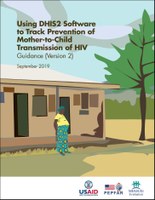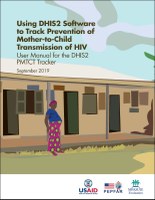Using DHIS2 Software to Track Prevention of Mother-to-Child Transmission of HIV
MEASURE Evaluation has published comprehensive guidance for developing an electronic solution using DHIS2 to track patients across the prevention of mother-to-child transmission (PMTCT) of HIV continuum of care. Our goal is to increase retention of mothers and their infants through the pregnancy and breastfeeding periods, and to improve linkages to care and referrals across services. This guidance and the accompanying documentation and resources are customized to address the complexities related to the PMTCT continuum of care, but the approaches and tools presented here can provide useful learning for the development of any DHIS2 tracker.
PMTCT Tracker Guidance Document
The guidance on how to develop a PMTCT tracker in DHIS2 can be accessed using the link below. This September 2019 version updates the guidance document published in 2018.
 |
Additional Documentation and Resources
Testing the PMTCT Tracker in Zimbabwe: A report outlining the findings and lessons learned from testing the PMTCT tracker in Zimbabwe can be accessed using the link below. These findings have been incorporated into the updated version of the guidance document.
 |
MEASURE Evaluation’s Sample PMTCT Tracker: A DHIS2 XML metadata import file containing the sample PMTCT Tracker can be downloaded using the link below.
Download the DHIS2 XML metadata file for the sample PMTCT Tracker
A detailed discussion of this sample PMTCT tracker configuration solution is included in Appendix A of the Guidance document. You can use this XML metadata import file to set up the sample PMTCT Tracker within your own DHIS2 server (versions 2.30-2.32) with the following steps:
- In order for the analytics (charts, pivot tables) included in this XML import to work properly, before importing this file you may need to replace the ID “ImspTQPwCqd” with the ID of the root organization unit for your own instance.
- Open the DHIS2 Import/Export app, choose the ‘Metadata import’ option, choose this file to upload, change the format to ‘XML’ and click the ‘Import’ button.
- Review the import results to ensure everything has imported correctly (even if it shows all objects imported, in some cases a bug in DHIS2 means you may need to import the file a second time in order for all permissions to load properly.)
- After importing this file, you will need to open the two programs and assign your organisation units to them, as well as give relevant users the appropriate PMTCT Roles and PMTCT User Groups.
User Manual for the PMTCT Tracker: This manual is intended for end users of MEASURE Evaluation’s DHIS2 PMTCT Tracker. It is also available as a Word document, so that you can easily adapt it to reflect any local customizations of the PMTCT tracker.
 | Using DHIS2 Software to Track Prevention of Mother-to-Child Transmission of HIV: User Manual for the DHIS2 PMTCT Tracker (Available in Word) |
|---|
Dummy data for the Sample PMTCT Tracker: This Excel file generates an XML import file containing dummy data for 24 PMTCT clients that can be loaded into the sample PMTCT Tracker for training and demonstration purposes:
Download the dummy data generator for the sample PMTCT Tracker
The Excel spreadsheet is dynamic and will always generate an XML import file based around today’s date (patients that are due in the next few days etc). These records are carefully constructed to show the full scope of the PMTCT workflow, and to display typical results in the Overdue Events report and sample PMTCT dashboard.
In order to import this file, you will need to use the DHIS2 API (full tracker records cannot be imported via the DHIS2 user interface). To generate and load the dummy data, use the following steps:
- This dummy data is based on two Sierra Leone organization units, but you can change this to be two organization units in your own DHIS2 server by updating the UIDs in the two yellow cells of the ‘Reference’ tab of the Excel file.
- Open the ‘XML’ tab of the Excel file.
- Copy the entire ‘XML’ worksheet and paste it into a text editor (this XML will be based on today’s date).
- Save the file as ‘dummy-data.xml’ or similar.
- You will need to use the DHIS2 API to import this file – the curl command is:
curl "[your server]/api/trackedEntityInstances" -X POST -H "Content-Type: application/xml" -d @'[file location]' -u [user]:[password] - For example, on the play.dhis2.org demo site, this might be:
curl "https://play.dhis2.org/2.32.2/api/trackedEntityInstances" -X POST -H "Content-Type: application/xml" -d @'dummy-data.xml' -u admin:district - Note that after importing this file, you will need to run the ‘Analytics Tables Update’ in your DHIS2 instance in order to see this newly imported data in the sample PMTCT dashboards.
If you have any technical questions or encounter any issues with importing these files, you can raise them with the wider DHIS2 community here: https://community.dhis2.org/t/using-dhis-2-software-to-track-prevention-of-mother-to-child-transmission-of-hiv-guidance.
Related Content
Webinar: Using DHIS 2 Software to Track Prevention of Mother-to-Child Transmission of HIV












